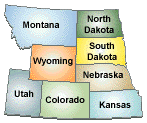
Flooding of open-pit mines is ongoing at several abandoned mines in Region
6. The flooding is caused by the incursion of groundwater into the open pit forming a
"pit lake." Water quality in these pit lakes varies from highly acidic to
alkaline. The Berkeley Pit in Butte, Montana is a 1.5 square mile open pit approximately
1,700 feet in depth. Ground water has infiltrated the open pit and created a pit lake
about 710 feet in depth containing 30 billion gallons of water with a pH of 2.5. Birds
landing in these acidic pit lakes can ingest this water which causes severe trauma to
their gastrointestinal tracts and eventual death. The acidic water also removes natural
oils from the birds’ feathers causing them to die by drowning or hypothermia. In
1995, the Berkeley Pit proved lethal to over 300 snow geese which used the pit lake as a
migratory stopping place.
Abandoned open pit uranium mines in Wyoming also have formed pit lakes. Uranium-bearing
formations are usually associated with strata containing high concentrations of selenium.
Pit lakes formed in open pit uranium mines can contain very high levels of selenium in the
water. One pit lake in Wyoming contains over 100 parts per million (microgram per Liter [µg/L]) of selenium. Waterborne selenium concentrations
greater than 2µg/L are known to impair the
reproduction and survival of aquatic birds due to the high potential for dietary toxicity
through food chain bioaccumulation. |



